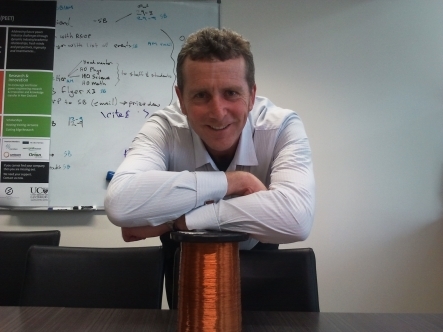Our Changing World for Thursday 20 September 2012
Speech-generating Tools for Children with Autism
 One in 100 children is affected by autism spectrum disorder, and most have difficulty communicating. Victoria University’s Jeff Sigafoos (left) is trying to identify the best communication tools for those children with autism who don’t speak. He’s been testing the three most common alternatives to speech for autistic children – sign language, pointing to pictures and electronic speech-generating devices, which include applications on the iPad or iPod Touch as well as a range of text-to-speech machines. Ruth Beran goes to his clinic in Wellington’s Karori, and watches as trainers Laura Roche and Michelle Stevens help six-year old Jonty Kingi use an iPad to generate speech and enable him to communicate. Jonty uses the iPad to request a break from an academic task like reading, or something he wants, like his favourite food or toy. The iPad has been programmed so that icons, such as a stop sign for taking a break, can be pressed and synthesise speech.
One in 100 children is affected by autism spectrum disorder, and most have difficulty communicating. Victoria University’s Jeff Sigafoos (left) is trying to identify the best communication tools for those children with autism who don’t speak. He’s been testing the three most common alternatives to speech for autistic children – sign language, pointing to pictures and electronic speech-generating devices, which include applications on the iPad or iPod Touch as well as a range of text-to-speech machines. Ruth Beran goes to his clinic in Wellington’s Karori, and watches as trainers Laura Roche and Michelle Stevens help six-year old Jonty Kingi use an iPad to generate speech and enable him to communicate. Jonty uses the iPad to request a break from an academic task like reading, or something he wants, like his favourite food or toy. The iPad has been programmed so that icons, such as a stop sign for taking a break, can be pressed and synthesise speech.
Autistic children who fail to develop speech are more prone to tantrums and aggression, mainly due to frustration at being unable to communicate. Tools like the iPad to generate speech may help reduce these behavioural problems.
Computational Genomics
In 2010 Murray Cox was one of the inaugural Rutherford Discovery Fellows. He’s a computational biologist at Massey University, working on a diverse range of topics, from settlement of the Pacific to the genetics of fungal pathogens. He applies sophisticated statistical analysis to the genome, which is an organism’s entire complement of DNA.
Alison Ballance heads to Palmerston North to talk with Murray Cox and PhD student Elsa Guillot to find out more about computational genomics and the kind of problems it can be used to solve. She hears how Murray recently worked out that modern Malagasy people on the island of Madagascar, off the coast of Africa, are descended from a group of about 30 Indonesian women who arrived there within the last 1500 years. Murray also explains why the spaces in between genes can be as important as genes themselves in answering some questions, and why less data can sometimes be more enlightening than lots of data.
A Smart Grid

Allan Miller, the director of the Electric Power Engineering Centre at the University of Canterbury, leads the “Renewable Energy and the Smart Grid” research project (image: V Meduna)
New Zealand is gearing up to generate 90 per cent of electricity from renewable sources by 2025. Already, 75 per cent comes from renewable sources, including hydro power, wind farms, and geothermal generation, but finding the additional 15 per cent will be a challenge, especially since the demand for electricity usually grows each year.
Some of the additional renewable generation is expected to come from households using photovoltaic rooftop panels to produce electricity for their own use and feeding excess power back into the national grid. Allan Miller, the director of the University of Canterbury’s Electric Power Engineering Centre, leads research to ensure that the grid is ready for it. Since both solar radiation and wind strength vary between seasons and on a daily basis, the research team has to look for ways of dealing with this variability to ensure a secure electricity supply.
The team will also investigate consumer behaviour and perceptions and survey the anticipated use of new technologies in the electricity network, including solar rooftop panels, home automation, electric vehicles, and demand management. Allan Miller says home automation could be used to make a household’s electricity demand respond to price signals from electricity retailers, and electric vehicles could provide a mechanism for storing electricity and controlling demand.
CeleBRation Choir
The CeleBRation choir at the University of Auckland’s Centre for Brain Research was established in 2009 as a social singing group for people with neurological conditions like stroke or Parkinson’s disease. But it’s also, at the suggestion of choir members, become the focus of a feasibility study by a group of researchers interested in measuring the benefits to choir members from their regular singing and socialising. The 12-week feasibility study showed an improvement in pitch with people with aphasia, and choir members reported improvements in speech as well as mood and feelings of well-being.
Alison Ballance heads to the University of Auckland’s Tamaki Campus to talk with Suzanne Purdy, head of Speech Science in the Department of Psychology, speech therapist and PhD student Sylvia Leao, and founder of the choir and Master’s student Laura Fogg who is also Communications and Liaison Manager at the Centre for Brain Research.
Alison Talmage is the music therapist running the CeleBRation choir, and other researchers involved in the study include Clare McCann from Speech Science, Lynette Tippett from the Department of Psychology at the University of Auckland, Kathryn McPherson – Director of the Person Centred Rehabilitation centre at the Auckland University of Technology, and Stephen Buetow from the Department of General Practice and Primary Health Care at the University of Auckland.
Radio New Zealand's One in Five programme ran a story about the choir back in 2010 - you can find that story here.
Mystery Sound
The tenth mystery sound from the opening theme is a Chatham Island tui (sings a much simpler song than tui on the mainland) – it featured in a two-part story about the translocation of tui from Rangatira/South East Island to main Chatham Island that was part of a series about the Chatham Islands. Here are links to the complete Chathams series:
Rangatira/South East Island - Department of Conservation ranger Abi Liddy introduces Alison Ballance to shore plovers, black robins and other unique species
Chatham petrels - Chatham petrels are one of the world's rarest seabirds, but simple innovative techniques have seen their numbers slowly recover
Rangatira Night Shift - At night Rangatira Island is alive with seabirds, wetas, spiders, and war whooping scientists catching Chatham petrels
Mangere Island Revegetation - Mangere Island in the Chathams has been the focus of New Zealand's most remote replanting project as Bridget Gibb explains
Chatham Island oystercatchers - Chatham Island oystercatchers have responded well to management that includes moving nests up the beach away from waves
Chatham Island Tui translocation part 1 - The Taiko Trust's 'Tui Team' are on Rangatira Island, attempting to catch 40 tui to move to the main Chatham Island
Chatham Island Tui release part 2 - The release of forty young tui into the Awatotara Valley is an historic occasion shared by many Chatham Islanders
Chatham Island Dune Restoration - Sand dune restoration projects are returning native sand-binding plants to Chatham Island dunes
Laser Scans of Moriori Dendroglyphs - Detailed 3D digital laser scans are preserving information about Moriori tree carvings on the Chatham Islands
Cooks Scurvy Grass in the Chathams - Each summer DoC botanist Amanda Baird monitors populations of the threatened coastal plant Cooks scurvy grass
Sweetwater Covenant, Chatham Island - The Chatham Islands boast many private conservation covenant covenants - and one even has a predator proof fence
Chatham Island Taiko - DoC ranger Pat Liddy is part of a team working to protect rare Chatham Island taiko during the breeding season
Taiko Rediscovery - David Crockett recounts the momentous rediscovery of the Chatham Island taiko